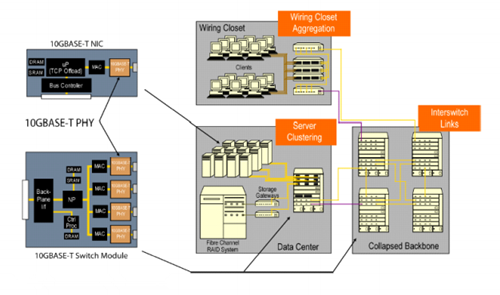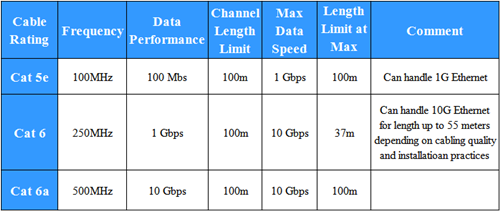Q: What is 10 Gigabit Ethernet?
As a part of the family of IEEE applications standards, 10G Ethernet is typically developed for copper and fiber optic cabling that support 10 Gigabit per second transmission rates. It offers a straightforward upgrade path for 10 Gigabit Ethernet backbones and makes provisions for linking Ethernet Local Area Networks (LANs) to Metropolitan and Wide Area Networks (MANs and WANs). The most commonly used 10G Ethernet optical devices nowadays is SFP+ transceivers and SFP+ cables. For example, 10G-SFPP-LR and PAN-SFP-PLUS-SR are SFP+ transceivers that can support a link length of 10km and 300m, respectively.
As a part of the family of IEEE applications standards, 10G Ethernet is typically developed for copper and fiber optic cabling that support 10 Gigabit per second transmission rates. It offers a straightforward upgrade path for 10 Gigabit Ethernet backbones and makes provisions for linking Ethernet Local Area Networks (LANs) to Metropolitan and Wide Area Networks (MANs and WANs). The most commonly used 10G Ethernet optical devices nowadays is SFP+ transceivers and SFP+ cables. For example, 10G-SFPP-LR and PAN-SFP-PLUS-SR are SFP+ transceivers that can support a link length of 10km and 300m, respectively.
Q: What about 10GBASE-T?
The IEEE 802.3an standard (certificated in 2006) described the 10GBASE-T application for operation over category 6/class E, augmented category 6/class E, and class F twisted-pair copper cabling. 10GBASE-T is not targeted for operation over category 5e/class D cabling. Category 6a is required to reach the full distance of 100 meters and category 6 may reach a distance of 55 meters depending on the quality of installation, determined only after re-testing to 500 MHz. Figure 1 illustrates the expected early deployment of 10GBASE-T in the data center.
The IEEE 802.3an standard (certificated in 2006) described the 10GBASE-T application for operation over category 6/class E, augmented category 6/class E, and class F twisted-pair copper cabling. 10GBASE-T is not targeted for operation over category 5e/class D cabling. Category 6a is required to reach the full distance of 100 meters and category 6 may reach a distance of 55 meters depending on the quality of installation, determined only after re-testing to 500 MHz. Figure 1 illustrates the expected early deployment of 10GBASE-T in the data center.

Q: How does the 10GBASE-T application support 10Gb/s transmission rates over twisted-pair copper cabling?
The 10GBASE-T application utilizes a pulse amplitude modulation (PAM-16) encoding scheme to transmit data at a rate of 800 Msymbols/sec. Transmission employs full-duplex (transmitting and receiving information at the same time) operation over all 4-pairs for a data rate of 2.5 Gb/s per twisted-pair. Sophisticated crosstalk (both near-end and far-end) and return loss cancellation technology are employed to increase available signal-to-noise margins.
The 10GBASE-T application utilizes a pulse amplitude modulation (PAM-16) encoding scheme to transmit data at a rate of 800 Msymbols/sec. Transmission employs full-duplex (transmitting and receiving information at the same time) operation over all 4-pairs for a data rate of 2.5 Gb/s per twisted-pair. Sophisticated crosstalk (both near-end and far-end) and return loss cancellation technology are employed to increase available signal-to-noise margins.
Q: There are so many 10GBASE-T acronyms. What do they mean?
DSP (Digital Signal Processor)—The device responsible for converting high frequency analog signals into digital form.
DTE (Data Terminal Equipment)—Any end-user device that converts information into data bits for transmission or converts received signals into end-user information.
MAC (Media Access Control)—A means for converting data into a form that can be sent over the network and for ensuring that data is being sent to the correct address. Data conversion involves cutting the data into sections (also called frames) and then adding error detection and recovery information. A MAC address is a numeric identifier that is unique to each device attached to a network.
OSI (Open Systems Interconnect)—A model developed by the ISO International Standards Organization to allow computer systems made by different vendors to communicate with each other. The purpose of OSI is to create a worldwide open systems networking environment where all systems are interoperable.
PHY (Physical Layer Interface)—The chip responsible for putting the signal onto the copper twisted-pair or fiber optic cabling channel. The PHY defines operational features such as transport medium, data rate, type of modulation, signaling specifics, transmit and receive synchronization, etc.
PMD (Physical Medium Dependent)—The quality and type (i.e. balanced twisted-pair or fiber optic) of the actual hardware that has to be used for data transmission. Hardware may include cables, connectors, transmitters, receivers, and optical bypass switches.
DSP (Digital Signal Processor)—The device responsible for converting high frequency analog signals into digital form.
DTE (Data Terminal Equipment)—Any end-user device that converts information into data bits for transmission or converts received signals into end-user information.
MAC (Media Access Control)—A means for converting data into a form that can be sent over the network and for ensuring that data is being sent to the correct address. Data conversion involves cutting the data into sections (also called frames) and then adding error detection and recovery information. A MAC address is a numeric identifier that is unique to each device attached to a network.
OSI (Open Systems Interconnect)—A model developed by the ISO International Standards Organization to allow computer systems made by different vendors to communicate with each other. The purpose of OSI is to create a worldwide open systems networking environment where all systems are interoperable.
PHY (Physical Layer Interface)—The chip responsible for putting the signal onto the copper twisted-pair or fiber optic cabling channel. The PHY defines operational features such as transport medium, data rate, type of modulation, signaling specifics, transmit and receive synchronization, etc.
PMD (Physical Medium Dependent)—The quality and type (i.e. balanced twisted-pair or fiber optic) of the actual hardware that has to be used for data transmission. Hardware may include cables, connectors, transmitters, receivers, and optical bypass switches.
Q: What are the main differences between the specifications for category 6 and augmented category 6 (Category 6A)?
Augmented category 6/class E cabling extends the frequency characterization of existing category 6/class E cabling requirements to 500 MHz, specifies increased insertion loss headroom (equivalent to class F performance), and includes new requirements for the parameter of alien crosstalk. Figure 2 shows a comparison between cat 5e, cat 6 and cat 6a.
Augmented category 6/class E cabling extends the frequency characterization of existing category 6/class E cabling requirements to 500 MHz, specifies increased insertion loss headroom (equivalent to class F performance), and includes new requirements for the parameter of alien crosstalk. Figure 2 shows a comparison between cat 5e, cat 6 and cat 6a.

Q: What is alien crosstalk?
Alien crosstalk is defined as crosstalk from cables adjacent to the cable that makes up the transmission channel. While other sources of noise such as near-end crosstalk and far-end crosstalk are mitigated by the PHY itself, for 10GBASE-T alien crosstalk is mitigated by the cabling media. Therefore, in reference to cabling, alien crosstalk and insertion loss are the primary parameters to consider for 10GBASE-T operation. In addition to the cabling transmission and coupling parameters, alien crosstalk as a function of insertion loss is specified to enable the evaluation of the combined affect of alien crosstalk and insertion loss. Alien crosstalk effects can be measured on the same end as the transmitter (ANEXT) or the opposite end of the transmitter (AFEXT). ANEXT, power sum ANEXT, AFEXT, and power sum AFEXT should be characterized to ensure support of the 10GBASE-T application.
Alien crosstalk is defined as crosstalk from cables adjacent to the cable that makes up the transmission channel. While other sources of noise such as near-end crosstalk and far-end crosstalk are mitigated by the PHY itself, for 10GBASE-T alien crosstalk is mitigated by the cabling media. Therefore, in reference to cabling, alien crosstalk and insertion loss are the primary parameters to consider for 10GBASE-T operation. In addition to the cabling transmission and coupling parameters, alien crosstalk as a function of insertion loss is specified to enable the evaluation of the combined affect of alien crosstalk and insertion loss. Alien crosstalk effects can be measured on the same end as the transmitter (ANEXT) or the opposite end of the transmitter (AFEXT). ANEXT, power sum ANEXT, AFEXT, and power sum AFEXT should be characterized to ensure support of the 10GBASE-T application.
Q: Are there field testers capable of determining category 6A performance?
At a minimum, field testers that comply with the level IIIe accuracy requirements specified in proposed TSB-155 will be required to assess installed cabling performance for all cabling parameters (except alien crosstalk) up to 500 MHz. It is under consideration that alien crosstalk may be assessed in the field via an auto-negotiation algorithm built into network equipment and initiated during equipment start-up.
At a minimum, field testers that comply with the level IIIe accuracy requirements specified in proposed TSB-155 will be required to assess installed cabling performance for all cabling parameters (except alien crosstalk) up to 500 MHz. It is under consideration that alien crosstalk may be assessed in the field via an auto-negotiation algorithm built into network equipment and initiated during equipment start-up.
评论
发表评论